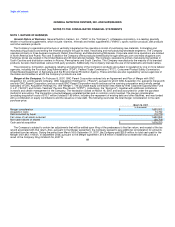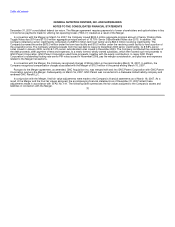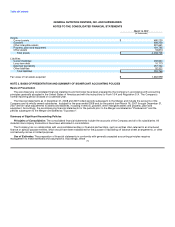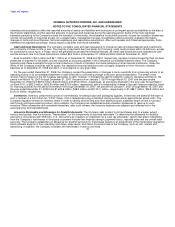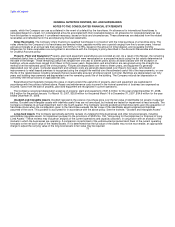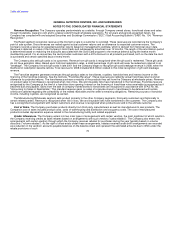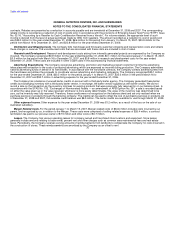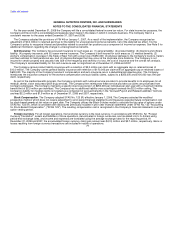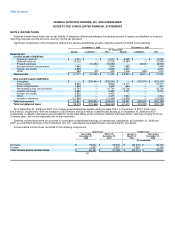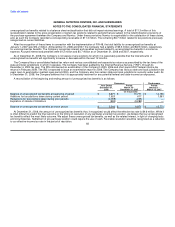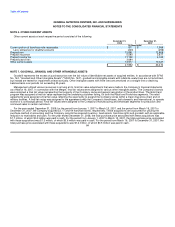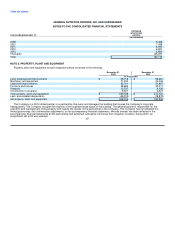GNC 2009 Annual Report Download - page 85
Download and view the complete annual report
Please find page 85 of the 2009 GNC annual report below. You can navigate through the pages in the report by either clicking on the pages listed below, or by using the keyword search tool below to find specific information within the annual report.
Table of Contents
GENERAL NUTRITION CENTERS, INC. AND SUBSIDIARIES
NOTES TO THE CONSOLIDATED FINANCIAL STATEMENTS
In December 2007, the FASB issued SFAS No. 141 (revised 2007), "Business Combinations" ("SFAS 141R"). SFAS 141R establishes
principles and requirements for how an acquirer in a business combination recognizes and measures in its financial statements the identifiable
assets acquired, the liabilities assumed and any noncontrolling interest in the acquiree at the acquisition date fair value. SFAS 141R
significantly changes the accounting for business combinations in a number of areas including the treatment of contingent consideration,
preacquisition contingencies, transaction costs, in-process research and development and restructuring costs. In addition, under SFAS 141R,
changes in an acquired entity's deferred tax assets and uncertain tax positions after the measurement period will impact the acquirer's income
tax expense. SFAS 141R provides guidance regarding what information to disclose to enable users of the financial statements to evaluate the
nature and financial effects of the business combination. SFAS 141R is effective for fiscal years beginning after December 15, 2008 with early
application prohibited. SFAS 141R also amends SFAS No. 109, "Accounting for Income Taxes", such that adjustments made to deferred taxes
and acquired tax contingencies after January 1, 2009, even for business combinations completed before this date, will impact net income. The
Company will adopt SFAS 141R beginning in the first quarter of fiscal 2009 and is currently evaluating the impact of adopting SFAS 141R on its
consolidated financial statements.
In December 2007, the FASB issued SFAS No. 160, "Noncontrolling Interests in Consolidated Financial Statements, an amendment of ARB
No. 51" ("SFAS 160"). SFAS 160 changes the accounting and reporting for minority interests, which will be recharacterized as noncontrolling
interests and classified as a component of equity. This new consolidation method significantly changes the accounting for transactions with
minority interest holders. SFAS 160 is effective for fiscal years beginning after December 15, 2008 with early application prohibited. The
Company will adopt SFAS 160 beginning in the first quarter of fiscal 2009 and is currently evaluating the impact of adopting SFAS 160 on its
consolidated financial statements.
In March 2008, the FASB issued SFAS No. 161, "Disclosures about Derivative Instruments and Hedging Activities", ("SFAS 161"), which
amends SFAS No. 133, "Accounting for Derivative Instruments and Hedging Activities" ("SFAS 133"). SFAS 161 requires companies with
derivative instruments to disclose information that should enable financial statement users to understand how and why a company uses
derivative instruments, how derivative instruments and related hedged items are accounted for under SFAS 133 and how derivative instruments
and related hedged items affect a company's financial position, financial performance, and cash flows. SFAS 161 is effective prospectively for
interim and annual periods beginning on or after November 15, 2008. The Company does not expect this statement to have a material impact
on its results of operations or financial condition.
In April 2008, the FASB issued FSP FAS 142-3, "Determination of the Useful Life of Intangible Assets" ("FSP FAS 142-3"), which amends
the factors that should be considered in developing renewal or extension assumptions used to determine the useful life of a recognized
intangible asset under FASB Statement No. 142, "Goodwill and Other Intangible Assets". The intent of FSP FAS 142-3 is to improve the
consistency between the useful life of a recognized intangible asset under Statement 142 and the period of expected cash flows used to
measure the fair value of the asset under SFAS No. 141,and other U.S. generally accepted accounting principles. The Company will consider
FSP FAS 142-3 at the effective date in the first quarter of 2009.
In October 2008, the FASB issued FSP No. 157-3, "Determining the Fair Value of a Financial Asset When the Market for That Asset Is Not
Active" ("FSP 157-3"). FSP 157-3 clarifies the application of SFAS 157 in a market that is not active and provides an example to illustrate key
considerations in determining the fair value of a financial asset when the market for that financial asset is not active. FSP 157-3 was effective
upon issuance for financial statements that have not been issued. The adoption of FSP 157-3 did not have a material impact on the Company's
financial assets and liabilities. 79


